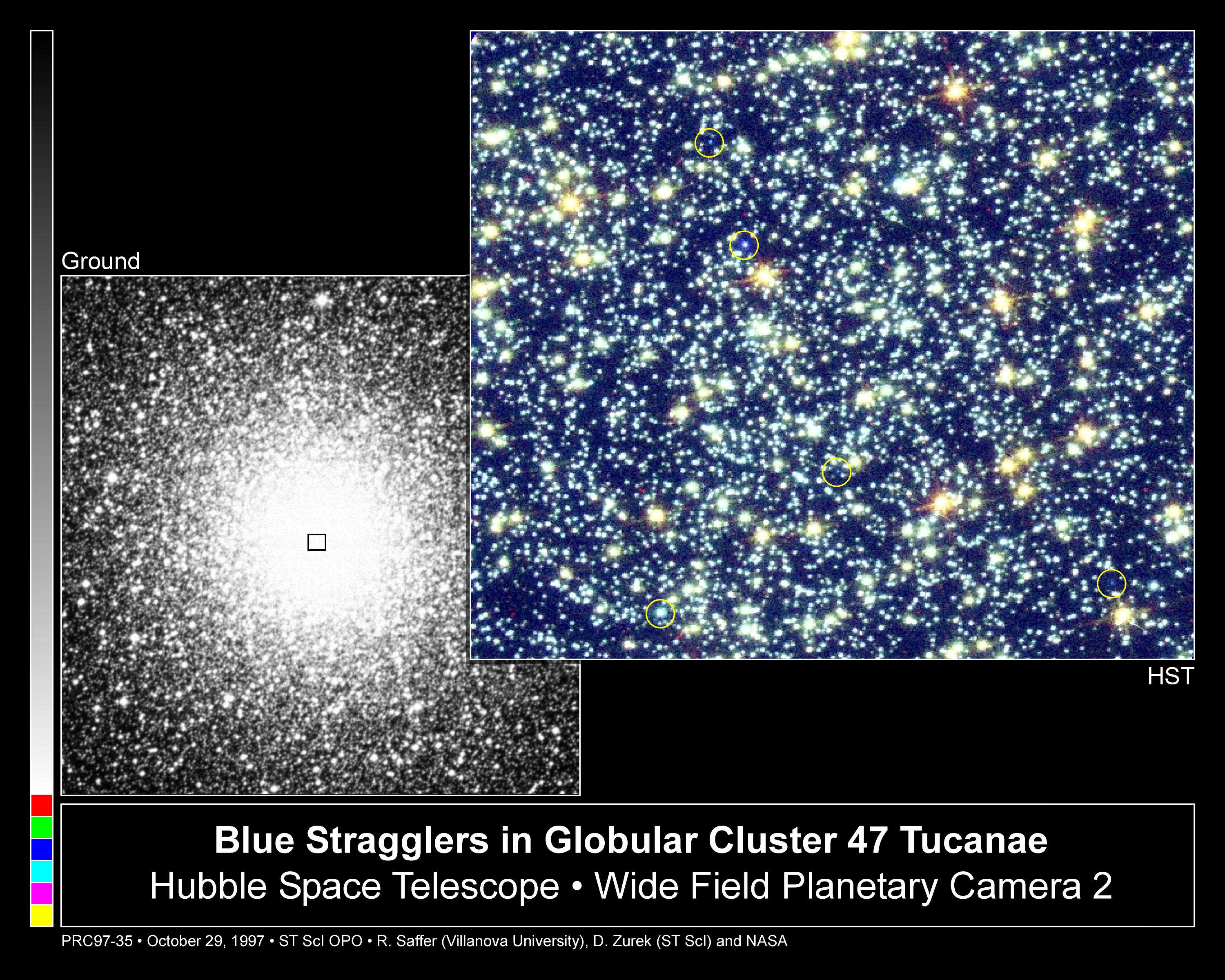[/caption]
Stars known as “blue stragglers” have stumped astronomers for years. Blue stragglers are found in open or globular clusters, and are hotter, bigger and bluer than other stars in the same vicinity. According to conventional theories, these massive stars should have died long ago because all stars in a cluster are born at the same time and should therefore be at a similar phase. Instead of being older, however, these massive rogue stars appear to be much younger than the other stars and are found in virtually every observed cluster. But now researchers have discovered these mysterious overweight stars are the result of ‘stellar cannibalism’ where plasma is gradually pulled from one star to another to form a massive, unusually hot star that appears younger than it is. The process takes place in binary stars – star systems consisting of two stars orbiting around their common center of mass. This helps to resolve a long standing mystery in stellar evolution.
Two theories for Blue Stragglers were that blue stragglers were either created through collisions with other stars or that one star in a binary system was ‘reborn’ by pulling matter off its companion.
The researchers, led by Dr. Christian Knigge from Southampton University and Professor Alison Sills from the McMaster University, looked at blue stragglers in 56 globular clusters. They found that the total number of blue stragglers in a given cluster did not correlate with predicted collision rate – dispelling the theory that blue stragglers are created through collisions with other stars.
They did, however, discover a connection between the total mass contained in the core of the globular cluster and the number of blue stragglers observed within in. Since more massive cores also contain more binary stars, they were able to infer a relationship between blue stragglers and binaries in globular clusters. They also showed that this conclusion is supported by preliminary observations that directly measured the abundance of binary stars in cluster cores. All of this points to “stellar cannibalism” as the primary mechanism for blue straggler formation.
“This is the strongest and most direct evidence to date that most blue stragglers, even those found in the cluster cores, are the offspring of two binary stars,” said Dr. Knigge. “In our future work we will want to determine whether the binary parents of blue stragglers evolve mostly in isolation, or whether dynamical encounters with other stars in the clusters are required somewhere along the line in order to explain our results.”
The research, which is part funded by the UK’s Science and Technology Facilities Council (STFC) will be published in the journal Nature on Thursday January 15.
Source: STFC


Just one give you kudos for the lovely title 😀
Another usual adopted alternative theory, other than binary star mass transfer or collision, for the origin of blue stragglers could also be created by the merging close binary stars. This is different from stellar collisions, as it implies stars on independent motions, whose orbits happen to intersect by so-called tidal capture. There are many examples of this theory available in the literature.
It is also interesting that many of these blue stragglers are centrally concentrated compared to the evolved stars. This is also not really new, being certainly known for more than a decade or even more. I.e.
Guhathakurta, P., “Globular Cluster Photometry with the HST. VII. Color Gradients and Blue Stragglers in the Central Region of M30 from WFP2 Observations.”; Astronomical Journal, 116, pg. 1757-1774 (1998) The origin of these “gravitational catastrophe” theory comes from D. Lynden-Bell and Roger Wood in 1968, who in turn, based their important proof on the original work of V.A. Antonov in 1962. Although very complex and mathematically beyond most of us, these works explain much about the evolution of globular cluster (and such stellar system) and the behaviours of stars within them.
NOTE: Suggest Frasier Cain might like to consider doing a general podcast on kinetic energy and angular momentum (and its conservation) in action in various forms of astronomical phenomena, which might explain much from issues with star formation to understanding how such stellar mergers might be possible,
Salacious… please go into detail about your alternative theory. Because I’m dying to know the difference between your “Merger” and the “collision or transference” explained by the text.
The sky from a planet near the center of the globular cluster may be amazing, however, I don’t think even simple lifeforms could ever develop in such a chaotic environment . It is great to know about some stars may have a 2nd or perhaps a 3rd chance in life
Mr. Oblivious.
Sorry, this is not my alternative theory at all, and to suggest so is purely antagonistic. Suggest you do a bit more reading.